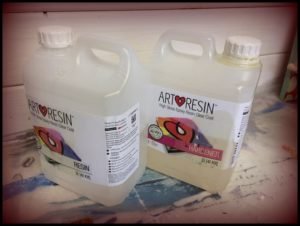Why Use Varnish or Resin on Your Paintings?
What I have found about acrylic paints is that, unless you use a gloss medium, when the paint is dry it loses a lot of its sheen and vibrancy and does not look as good as it did when the paint was wet.
One way to get around this is to coat the painting with a gloss finish, whether that be varnish or resin.
Varnish Options
Sometimes it is hard to find a particularly thick and strong gloss varnish as I found that acrylic varnishes seemed to be a bit wishy-washy for want of another phrase. So for my fluid acrylic paintings I started to use an oil varnish – this gave it a much better finish and I still use this sometimes depending on what kind of painting I have created.
Another varnish I have used is a polyurethane one which you can get at DIY stores and online. I mostly used this on my textured work but occasionally on some fluid acrylic paintings too. The thing about this varnish is that it does have a slightly yellow sheen so I would only use it on paintings that did not have white on them (otherwise that would look a yellowish colour).
Resin
What I now use purely on my fluid acrylic paintings is a resin coating. This gives a fantastic finish that means the paint still looks like it did when it was wet but also it gives a very slight soft focus appearance and also as if the painting has a glass coating. It really makes the painting extra special.
You can get resin these days that is specifically designed to be used on artwork and that is non-toxic. It is not cheap and if you want a decent coat of it on your paintings then you will likely use it up pretty quickly!
You can buy resin online from specialist chemical companies and also some of them sell it through Amazon so I will post the links on the recommended products page. My favourite resin that gives me the best results is ArtResin which I believe is from a US company but you can also get it in the UK (and they ship worldwide at a cost!)

Mixing in the Right Proportions
You need to be careful when you use it to mix it in the right proportions (some specify ratios according to weight and/or volume which can be different as the density of the resin and the hardener can differ).
There are resins available that make it easy for you so that you just mix the resin and hardener in a 1 to 1 ratio.
You will need to have somewhere flat and not too dusty for the resin to dry for a number of hours once you have put it on the painting (I usually just leave it overnight to be sure) and where it won’t be disturbed.
If you don’t think the first layer you have added is thick enough then you can just add another coat once it is dry.
I can’t emphasise how great I think that the resin looks on fluid acrylic paintings, bringing out the colours and just making it look like water encapsulated under glass so if you get a chance to try it then you really should do so. It also gives it a very slightly soft focus effect.
How Much to Use
There is a guide on the Art Resin website to advise you how much resin to use but I have found that this is too much and so using trial and error I have come up with my own guide as to how much resin to use on paintings.